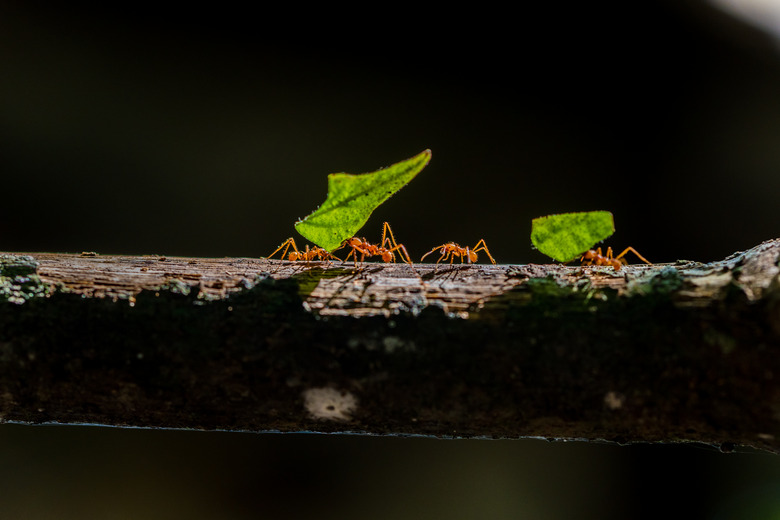Advantages & Disadvantages Of Biological Control
Controlling pests with their natural enemies, including parasites, predators, diseases and competing organisms, is called biological control. It is an alternative to using broad-spectrum pesticides, which kill off beneficial insects as well as pest organisms. To choose a successful biological control program, it is crucial to identify the pest along with its population levels and the circumstances of the infestation.
Minimized Safety Concerns
Minimized Safety Concerns
Unlike chemical pesticides, biological control agents, also called bioagents, leave behind no long-lasting residues that remain in the environment. They don't leach into groundwater or create resistant strains of insects. Biological control minimizes environmental, legal and public safety concerns. Integrated pest control uses bioagents in combination with other measures.
Increased Selectivity
Increased Selectivity
Often a host-parasite or prey-predator relationship is a specific one that doesn't affect other organisms — a benefit for the environment. For instance, when using nematodes for insect control, it's important to use the correct species for the insect you want to control. Biological-control nematodes aren't parasitic on their host. They enter the insect through a natural body opening and then eat a bacteria they carry with them that multiplies inside the host. Nematodes have to be the right size to enter the particular insect and must have behavior that allows contact with the insect to begin with.
Cost Considerations
Cost Considerations
Biological control can either be less or more expensive than pesticides. You can incur significant expense studying, choosing, testing and breeding a bioagent. However, in cases in which bioagents are applied to low-level pest populations, pest control can be long-term and inexpensive. Some fungi attack insects and kill them. A fungal spore penetrates the insect and grows throughout it. It takes about a week for the insect to die. Fungi are cost-effective unless a high application rate is needed for heavy insect infestations.
Dedication of Time
Dedication of Time
Bioagents may act over several generations or more to successfully manage pest populations. The imported fire ant, a serious pest in the southern United States, is parasitized by a tiny phorid fly native to its South American range. When the phorid fly is bred and released into the imported fire ant's U.S. range, less than 3 to 4 percent of the ants in a colony become infected. The effect of phorid flies on imported fire ant colonies could take years to become evident.
Skill Level
Skill Level
It may be more difficult for a nonprofessional to accomplish biological control given the many variables involved and the specialized knowledge of pests, bioagents and environmental conditions often needed for success. For instance, microbial pathogens are most effective when young caterpillars are feeding. In Hawaii, it took two kinds of parasitic wasps, an egg parasitoid and a parasite of the larvae, to successfully control the banana skipper — a moth larva that damages banana leaves.
New Pests
New Pests
Sometimes when a non-native bioagent is introduced to control a non-native pest species, it, in turn, becomes a pest. The multicolored Asian lady beetle was introduced into the United States for control of aphids. It became a pest insect that invades homes for overwintering. In Hawaii, the small Indian mongoose was introduced to control snakes and rats in sugarcane fields. It also preys on native Hawaiian birds, amphibians, reptiles and poultry. About $50 million in annual damages in Hawaii and Puerto Rico result from mongoose depredation. Modern methods greatly lessen the possibility of introducing harmful species.
References
- University of California Integrated Pest Management Program: Biological Control and Natural Enemies
- Extension: Fungi for the Biological Control of Insect Pests
- The University of Texas at Austin Fire Ant Project: FAQ – Answers
- Purdue University: Who Let the Bugs Out?: Biological Control
- University of Hawaii Extension Entomology: Pelopidas Thrax (Linnaeus)
- Pennsylvania State University Extension: Multicolored Asian Lady Beetle (Ladybug)
- Columbia University: Introduced Species Summary Project: Small Indian Mongoose (Herpestes auropunctatus)
- University of California Integrated Pest Management Program: Definition of Integrated Pest Management
Cite This Article
MLA
Csanyi, Carolyn. "Advantages & Disadvantages Of Biological Control" sciencing.com, https://www.sciencing.com/advantages-disadvantages-biological-control-8088070/. 13 March 2018.
APA
Csanyi, Carolyn. (2018, March 13). Advantages & Disadvantages Of Biological Control. sciencing.com. Retrieved from https://www.sciencing.com/advantages-disadvantages-biological-control-8088070/
Chicago
Csanyi, Carolyn. Advantages & Disadvantages Of Biological Control last modified August 30, 2022. https://www.sciencing.com/advantages-disadvantages-biological-control-8088070/
